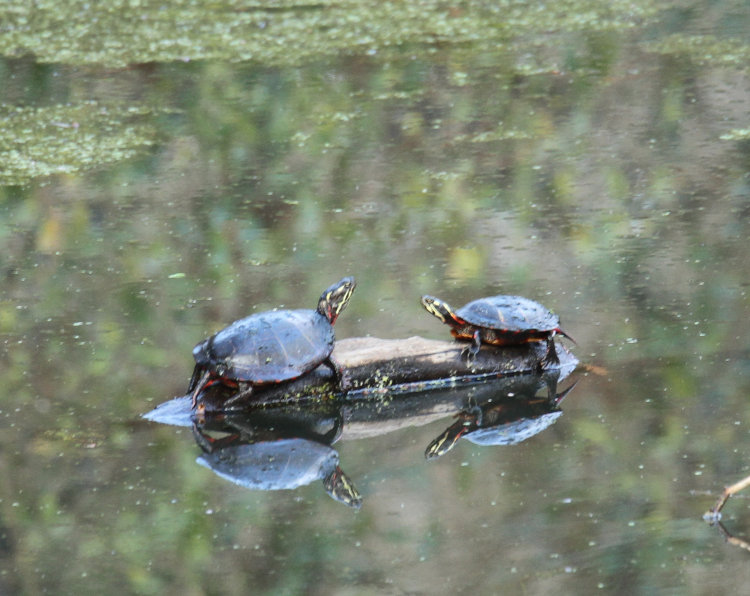Surprisingly so, like about 23°c, with even some sun for a little while. And don’t ask me how they know this when they’re mostly submerged, but the turtles were taking full advantage of it.

These two eastern painted turtles (Chrysemys picta picta) were perhaps a little longer than your palm – hard to judge while out in the middle of the pond, while I was shooting at 600mm from the deck so I wouldn’t spook them. I’ve seen too few painted turtles in the past several years, so it’s good to know they’re reasonably well-populated in the pond. No, I don’t count “two” as “reasonably well-populated,” but they weren’t the only two seen at that moment.

That’s two more there, stacked atop one another to the left, with three yellow-bellied sliders (Trachemys scripta scripta) sharing the same small tussock. At least, I’m considering all of these species to be the most likely, because they’re too far to be absolutely sure about subspecies, but if I can’t tell, I’m probably not misleading you about them. Scale-wise, I can do a little better here, because that tussock is closer to shore and I can judge a little more accurately: the biggest one is likely 25-30cm in carapace length. One particular day in late summer, as I patrolled the edges, I spooked perhaps two dozen basking turtles into the depths – the pond hosts a lot of them.
One more shot.

That’s a pair of mallards (Anas platyrhynchos) of course, male and female, but the quality of the photo gives a hint that these weren’t the subject that I was after. Instead, we have to look up at the tip of that branch that sits above their heads. Yes, that’s another turtle up there, smaller than your palm, too distant to guess what species it might be, but likely more of the sliders. I had initially thought it was one of the mud/musk turtles from the size, but that carapace seems to be shaped incorrectly for that. Unless that’s only seaweed or muck forming the peak, in which case it might be a mud or musk turtle, which have uniformly rounded, oval shells – I always think of them as hand grenades. Certainly not the highest I’ve seen one basking, but still a pretty good climb from the surface.
Now, a curiosity. This guy was there for some time, while the ducks (at least six of them, but probably more) went back and forth alongside and indeed right underneath it, and the turtle didn’t budge. Had I gone down the the water’s edge, though, the turtle likely would have bailed its perch before I got within four or five meters – they are clearly not tolerant of close approaches by people here, though I’ll be working on this. Reptiles and amphibians don’t have elaborate brains in the slightest, but they appear able to instinctively differentiate between harmless ducks and humans, even though I’m fairly confident they’ve never had a dangerous encounter with humans either.
Which brings to mind a distant memory from when I was snorkeling in Florida, about twenty years ago. I saw an unfamiliar turtle basking high on a rock near where I was swimming, and was able to get quite close to it by remaining down in the water. I was clearly larger than any regular denizen of those waters (save for dolphins and manatees,) shaped differently, and certainly a different color, so it seemed that being in the water was all that was necessary. Now, perhaps if I crawled on my belly up to the pond edge, the turtles here might ignore me – maybe I’ll try that sometime, just for giggles. The neighbors can’t see down to the pond and The Girlfriend learned long ago to ignore me, sometimes even when I’m out shooting, so no worries there.
I never did pin down what that turtle in Florida was, by the way; it was a dark species, but seemed to have a grey hood across the top and back of the head, about 20-25cm in carapace length, with a fairly high carapace. Notably, it was basking on a rock that was in a primarily saltwater sound, though it did not seem to be any saltwater species – it might have been one of the map turtles. Eventually, it bailed before I got close enough to try and capture it, though I’d made it to within a few meters by then.



















































